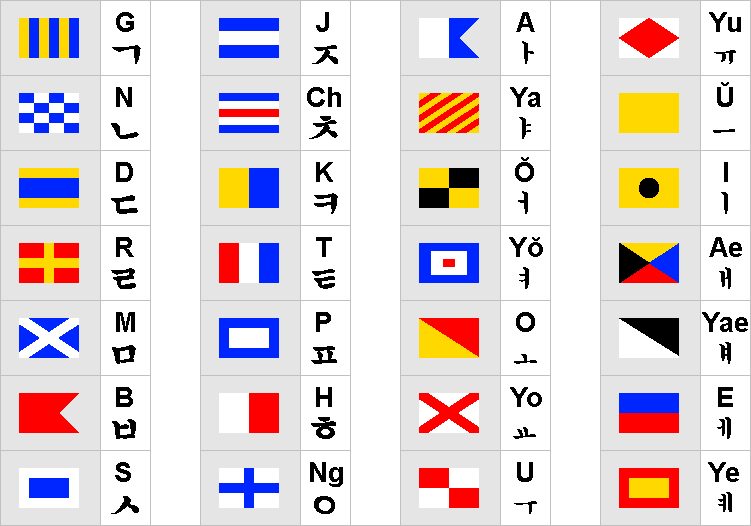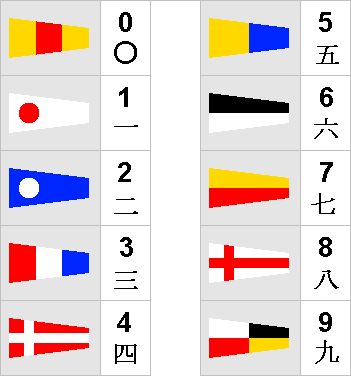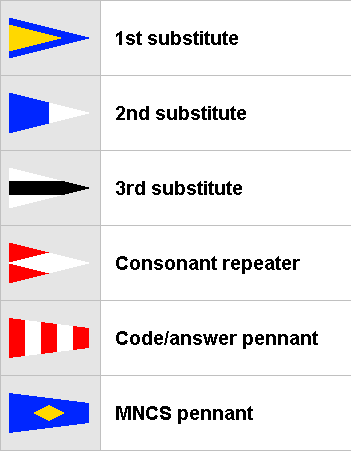Menghean Navy Code of Signals
The Menghean Navy Code of Signals, previously known as the Menghean Maritime Code of Signals and abbreviated MNCS or MMNS respectively, is a system of flag signals used by the Menghean Navy from the 1930s onward. It is similar in structure and function to the International Code of Signals, but its letters are based on the Menghean Sinmun alphabet rather than the 26-letter alphabet used in Eastern Casaterra. As such, it has a different combination of flags, some of which correspond to flags in the ICS and some of which are unique to Menghe.
Today, most civilian shipping in Menghe uses the International Code of Signals (ICS) to report the status of a vessel or request medical assistance, and the MNCS to communicate phonetic messages, signaling the use of either system with code pennants. The Menghean Navy uses the MNCS for both vocabulary and phonetic messages, but can also use the same set of flags to communicate with foreign vessels according to the ICS.
History
The Menghean Navy developed its first unified code of signals in 1909, after the formation of the Federative Republic of Menghe. Prior to this time, ships in the Sinyi and Namyang navies had used their own systems of signal flags, which were developed for military use only. These flag systems lacked any phonetic component, instead using combinations of colored flags to transmit specific vocabulary messages.
During the drafting of the International Code of Signals in the early 1930s, Menghe objected that the proposed set of signal flags did not suit the needs of the Menghean language. Though this complaint did not change the final form of the ICS, it did lead the Imperial Menghean Navy to request the drafting of a modified set of signal flags for Menghe. This task fell to a committee led by Ri Yong-chŏl, who opted for a compromise arrangement: letters shared by the Anglian and Sinmun alphabets would be represented by ICS flags, while ICS flags representing consonants absent in Menghean would be repurpused to represent Menghean vowels absent in Anglian. Because the simplified Sinmun alphabet chosen by Ri had 28 letters rather than 26, this still required the introduction of two new flags, which Ri's committee assigned to two uncommon vowels. A consonant repeater pennant and an MMNS code pennant ("I wish to communicate using the Menghean Maritime Code of Signals") were also adopted.
Because of the extensive similarity between the two systems, Menghean ships with a full set of MMNS flags can also communicate according to ICS rules. Foreign ships with a full set of ICS flags can send almost any message via the MMNS, though this requires the use of substitute flags. Ri's committee reasoned that this similarity would eliminate the need for ships transiting between Menghean and foreign waters to carry duplicate sets of signal flags, though guidebooks for interpreting signals would have to be duplicated.
The final version of the MMNS entered into force on 1 January 1935, one year after the official implementation of the ICS and months before the outbreak of war with Sylva. Polvokia, which also uses the Menghean language in its naval forces, adopted the MMNS in 1936 or 1937. The MMCS saw widespread military use during the Pan-Septentrion War, serving as the Menghean Navy's primary signalling system during that conflict, but gained little traction elsewhere.
Following Menghe's surrender in 1945, the Allied powers required that Menghean civilian ships instead fly their flags in accordance with the International Code of Signals. Menghean warships followed suit after the Republic of Menghe Navy was established in 1953. Following the end of the Menghean War of Liberation in 1964, the Democratic People's Republic of Menghe reinstated the MMCS for both military and civilian vessels in Menghean waters. This created significant obstacles to foreign trade, as the MMCS was still not well-known abroad, but the DPRM's relative economic isolation allowed the system to persist.
In 1995, Menghe's civilian maritime regulatory authority formally required the use of ICS signals by civilian ships in order to facilitate communication between Menghean and foreign vessels. From 1989 onward, it had already become common for foreign ships to use ICS signals in Menghean waters, but the new regulations granted this a legal foundation. The Menghean Navy, however, continues to use the MMCS, which was rebranded as the Menghean Navy Code of Signals.
As part of a military restructuring program after the Innominadan Crisis, the Innominadan Republican Navy adopted MNCS flag vocabulary to facilitate coordination with Menghean warships. The naval forces of Argentstan also use the Menghean Navy Code of Signals. Namhae Front member states on the continent of Meridia, however, have not adopted the MNCS as of 2022.
Letters
The standard form of the Menghean Sinmun alphabet has 19 consonants and 21 vowels, for a total of 40 letters. The Menghean Navy Code of Signals uses two simplifying rules to reduce the number of letter flags:
- The five faucalized double consonants (ㄲ, ㄸ, ㅃ, ㅆ, ㅉ) are represented by a single consonant (ㄱ, ㄷ, ㅂ, ㅅ, ㅈ, respectively) and a special consonant repeater flag.
- The seven digraph vowels (ㅚ, ㅟ, ㅢ, ㅘ, ㅝ, ㅙ, ㅞ) are represented by flying the flags of the two vowels that comprise the digraph, for example ㅗ (o) and ㅏ (a) to represent ㅘ (wa). Because the Menghean language does not permit two consecutive (non-digraph) vowels in a single word, this is unambiguous.
With the removal of these twelve letters, the MNCS has a total of twenty-eight letter flags, comprised of 14 consonants and 14 vowels. These are represented in the following way:
- The letters A, B, D, E, G, H, I, J, K, M, N, O, P, R, S, T, and U, which exist in both Menghean and Anglian, are represented by the ICS flag corresponding to the same letter.
- The letters Ch, Ng, Ya, Ŏ, Yŏ, Yo, Yu, and Ae are represented by ICS flags which correspond to letters absent in the Menghean alphabet, namely C, X, Y, L, W, V, F, and Z respectively.
- The letters Yae and Ye are represented by two new flags not present in the ICS.
The image below illustrates the twenty-eight MNCS signal flags for letters, with consonants on the left and vowels on the right.
Digits
The ten digits 0 through 9 use the same pennants as the ICS. Although grammatically correct Menghean uses place names with numbers, such that one hundred fifty seven would be 일백오십칠 (ilbaek osib chil, "one+hundred five+ten seven"), in the MNCS numbers are spelled out with digits alone, i.e., 1+5+7. As in the ICS, the "Code/answer pennant" (see next section) can be used to represent a decimal point when used in a group of numerical digits.
Repeaters and special flags
The first substitute, second substitute, and third substitute are also borrowed from the ICS, and have the same functions, repeating the first, second, and third flag of a hoist within the same hoist. The code/answer pennant is also similar in function, held at the dip while receiving a message and hauled up when the message is understood, while also representing a decimal point in numbers.
The consonant repeater pennant is unique to the MNCS, and is flown immediately after a consonant flag (ㄱ, ㄷ, ㅂ, ㅅ, or ㅈ) to convert it into a digraph representing a faucalized consonant (ㄲ, ㄸ, ㅃ, ㅆ, or ㅉ, respectively).
The MNCS pennant, a blue pennant with a gold diamond in the center, can be hoisted alone to signal "I would like to communicate in accordance with the MNCS." If the receiving ship hoists its MNCS pennant, this signals that the receiver has a set of MNCS flags and an MNCS guidebook and is able to communicate. A "Mike" flag hoisted alone means "I do not have a set of MNCS signal flags, but I have an MNCS guidebook and can communcate using ICS flags." The MNCS pennant can also be flown on top of a message to indicate that it should be read according to the Menghean Navy Code of Signals, not the International Code of Signals.
Compatibility with the ICS
The Menghean Navy Code of Signals was developed to balance two competing imperatives: to accurately represent the Menghean Sinmun alpbabet while also maintaining compatibility with the ICS where possible. Therefore, it uses nearly the same set of flags as the ICS, and among those, 17 flags represent the same letter in both systems and all numbers and repeaters are identical. The main difference between the two systems' phonetic flag use is that the MNCS substitutes unused Anglian letters for additional Menghean letters, for example, X-Ray for "Ng" or an initial empty space.
The MNCS flag set includes only four signals which are absent in the ICS: Yae, Ye, the consonant repeater, and the MNCS pennant. If a ship only possesses a set of ICS flags, it can hoist the "Mike" flag at the start of its exchange to indicate that it lacks these signals and will have to substitute others:
- India + Zulu (Menghean IAE) stands in for Yae.
- India + Echo (Menghean IE) stands in for Ye.
- Standard repeater flags stand in for the consonant repeater.
The current version of the MNCS, released in 1997, also uses the same single-flag meanings as the ICS, so that simple messages like "negative" and "man overboard" can be communicated between ships with ICS and MNCS guidebooks. Multi-flag signal codes, however, differ between the two systems, with the MNCS codes prioritizing military messages.


